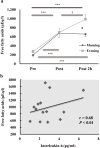Effects of Acute Endurance Exercise Performed in the Morning and Evening on Inflammatory Cytokine and Metabolic Hormone Responses
- PMID: 26352938
- PMCID: PMC4564197
- DOI: 10.1371/journal.pone.0137567
Effects of Acute Endurance Exercise Performed in the Morning and Evening on Inflammatory Cytokine and Metabolic Hormone Responses
Abstract
Purpose: To compare the effects of endurance exercise performed in the morning and evening on inflammatory cytokine responses in young men.
Methods: Fourteen healthy male participants aged 24.3 ± 0.8 years (mean ± standard error) performed endurance exercise in the morning (0900-1000 h) on one day and then in the evening (1700-1800 h) on another day with an interval of at least 1 week between each trial. In both the morning and evening trials, the participants walked for 60 minutes at approximately 60% of the maximal oxygen uptake (VO2max) on a treadmill. Blood samples were collected to determine hormones and inflammatory cytokines at pre-exercise, immediately post exercise, and 2 h post exercise.
Results: Plasma interleukin (IL)-6 and adrenaline concentrations were significantly higher immediately after exercise in the evening trial than in the morning trial (P < 0.01, both). Serum free fatty acids concentrations were significantly higher in the evening trial than in the morning trial at 2 h after exercise (P < 0.05). Furthermore, a significant correlation was observed between the levels of IL-6 immediately post-exercise and free fatty acids 2 h post-exercise in the evening (r = 0.68, P < 0.01).
Conclusions: These findings suggest that the effect of acute endurance exercise in the evening enhances the plasma IL-6 and adrenaline concentrations compared to that in the morning. In addition, IL-6 was involved in increasing free fatty acids, suggesting that the evening is more effective for exercise-induced lipolysis compared with the morning.
Conflict of interest statement
Figures


Similar articles
-
Is there a morning-to-evening difference in the acute IL-6 and cortisol responses to resistance exercise?Cytokine. 2011 Aug;55(2):318-23. doi: 10.1016/j.cyto.2011.05.005. Epub 2011 May 31. Cytokine. 2011. PMID: 21632260
-
Effects of time-of-day on the noradrenaline, adrenaline, cortisol and blood lipidome response to an ice bath.Sci Rep. 2025 Jan 8;15(1):1263. doi: 10.1038/s41598-025-85304-8. Sci Rep. 2025. PMID: 39779795 Free PMC article.
-
Morning-evening differences in response to exhaustive severe-intensity exercise.Appl Physiol Nutr Metab. 2014 Feb;39(2):248-54. doi: 10.1139/apnm-2013-0140. Epub 2013 Sep 13. Appl Physiol Nutr Metab. 2014. PMID: 24476482
-
Morning and evening exercise.Integr Med Res. 2013 Dec;2(4):139-144. doi: 10.1016/j.imr.2013.10.003. Epub 2013 Oct 14. Integr Med Res. 2013. PMID: 28664065 Free PMC article. Review.
-
Nrf2 modulates the benefits of evening exercise in type 2 diabetes.Sports Med Health Sci. 2023 Sep 9;5(4):251-258. doi: 10.1016/j.smhs.2023.09.001. eCollection 2023 Dec. Sports Med Health Sci. 2023. PMID: 38314046 Free PMC article. Review.
Cited by
-
Effect of time of day of recreational and household physical activity on prostate and breast cancer risk (MCC-Spain study).Int J Cancer. 2021 Mar 15;148(6):1360-1371. doi: 10.1002/ijc.33310. Epub 2020 Oct 7. Int J Cancer. 2021. PMID: 32976649 Free PMC article.
-
Effects of Different Intensities of Endurance Exercise in Morning and Evening on the Lipid Metabolism Response.J Sports Sci Med. 2016 Aug 5;15(3):467-476. eCollection 2016 Sep. J Sports Sci Med. 2016. PMID: 27803625 Free PMC article.
-
Time-of-Day-Dependent Physiological Responses to Meal and Exercise.Front Nutr. 2020 Feb 28;7:18. doi: 10.3389/fnut.2020.00018. eCollection 2020. Front Nutr. 2020. PMID: 32181258 Free PMC article. Review.
-
A review of cytokine-based pathophysiology of Long COVID symptoms.Front Med (Lausanne). 2023 Mar 31;10:1011936. doi: 10.3389/fmed.2023.1011936. eCollection 2023. Front Med (Lausanne). 2023. PMID: 37064029 Free PMC article.
-
Exercise Timing Matters for Glycogen Metabolism and Accumulated Fat Oxidation over 24 h.Nutrients. 2023 Feb 23;15(5):1109. doi: 10.3390/nu15051109. Nutrients. 2023. PMID: 36904109 Free PMC article. Review.
References
-
- Gleeson M. Immune function in sport and exercise. J Appl Physiol. 2007;103: 693–699. - PubMed
-
- Papanicolaou DA, Petrides JS, Tsigos C, Bina S, Kalogeras KT, Wilder R, et al. Exercise stimulates interleukin-6 secretion: inhibition by glucocorticoids and correlation with catecholamines. Am J Physiol. 1996;271: E601–605. - PubMed
-
- Giraldo E, Garcia JJ, Hinchado MD, Ortega E. Exercise intensity-dependent changes in the inflammatory response in sedentary women: role of neuroendocrine parameters in the neutrophil phagocytic process and the pro-/anti-inflammatory cytokine balance. Neuroimmunomodulation. 2009;16: 237–244. 10.1159/000212384 - DOI - PubMed
-
- Steensberg A, Toft AD, Schjerling P, Halkjær-kristensen J, Pedersen BK, Schjer P, et al. Plasma interleukin-6 during strenuous exercise: role of epinephrine. Am J Physiol Cell Physiol. 2001;281: C1001–1004. - PubMed
Publication types
MeSH terms
Substances
LinkOut - more resources
Full Text Sources
Other Literature Sources
Medical

